Design and Construction of Reservoir Flood Discharge Warning System
A flood warning system will be built for medium and large reservoir hydropower stations that have not built a flood warning system; a central control station will be set up in the central control room of the reservoir, and multiple flood warning early warning radio broadcasting equipment will be set up along rivers and residential areas along the downstream to 500 meters. The scope of early warning is arranged in the two sides of the river (the number of people can be determined according to the actual environment, and full coverage can be considered). In order to ensure early and effective early warning of the people along the Yangtze River before flood release, the safety of life and property of people along the river can be guaranteed.
The entire system consists of a control center, an alert station, and a walkie-talkie. When the warning information is issued, the control host sends an early warning instruction and warning information. The warning station receives the warning information and makes an early warning report according to the warning instructions. In emergency situations, Emergency walkie-talkies can be used to alert and warn specific warning sites. The communication mode adopts the ISM+GPRS dual-channel approach, which can be used simultaneously to further improve reliability.
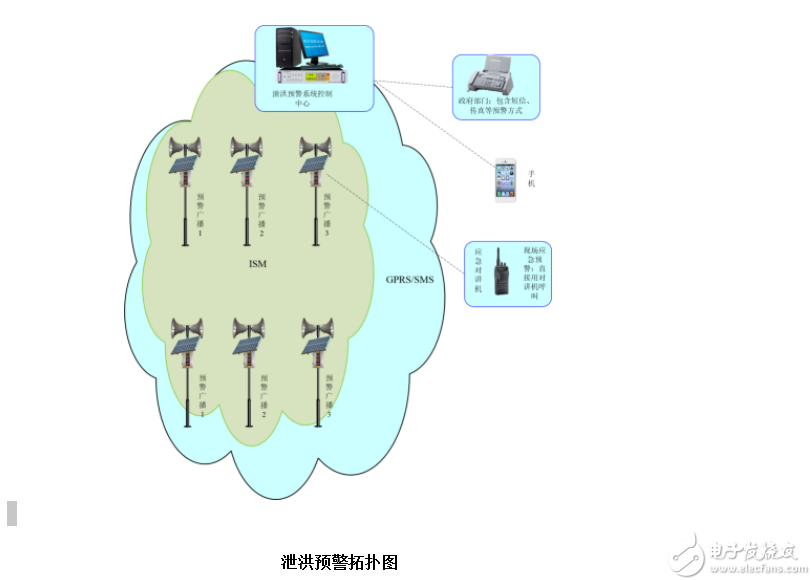
The control center is located in the reservoir hydropower station's dispatch center. Once a flood that may cause a major impact is released, an early warning is issued one hour in advance to remind residents along the river to pay attention to flood risks and impacts. Early warning broadcasting stations are laid along the lower reaches of the river, and are mainly built in flood-prone areas along the river in the tourist areas and residential areas that are easily flooded along the river in Gongbu city. The specific construction scope is determined based on flood discharge and flood risk analysis results.
skills requirement
Flood Warning System Performance and Requirements
Design requirements
The system generally requires two medium-sized reservoir construction flood discharge early warning systems. Each system consists of a central control station and 15 sets of flood warning terminal equipment (including horns, solar panels, batteries installed in the control box, power supply devices, control panels, etc.) And related relay equipment components. The central control station is located in the central control room of the reservoir hydropower station; downstream nomadic sites are installed with no less than 15 sets of flood broadcasting equipment (preferably full coverage) to provide early warning. The central control station has a one-touch warning button that can directly control the early warning of the flood discharge warning terminal, upload the warning information to the county-level platform, and also can receive the warning information sent by the county-level monitoring platform and make an alarm. The flood warning terminal equipment adopts the wireless propagation (4G LTE) method for early warning broadcasting and alarming, receives the predicted information of the central control station and the county-level monitoring platform, and has self-checking and self-diagnosis functions, and can timely feedback the failure information to the wireless transmission method. County monitoring platform. Flood discharge broadcasting equipment, etc. shall have anti-theft alarm function. Since there is no AC power supply along the river, the flood discharge broadcasting equipment should adopt the new energy (solar energy) self-power supply method.
Central Control Station
The central control station has a one-touch warning button that can directly control the early warning of the flood discharge warning terminal, upload the warning information to the county-level platform, and also can receive the warning information sent by the county-level monitoring platform and make an alarm.
Communication requirements
(1) It must have a 7-module full-meeting network module with 4G LTE communication capabilities.
(2) Text-to-speech function (word number is not less than 500 words, voice broadcast is smooth, and supports multiple polyphonic characters). The number of replays of broadcast SMS can be configured from 1 to 99 times, and the broadcast SMS content can be monitored (return to the platform or designated number SMS content).
(3) With one-button alarm button and pre-alarm time setting function, use operator-specific Internet of Things sim card, sim card do not have voice function; all pre-alert data use encrypted transmission to prevent information security problems.
Performance requirements
(1) Precautionary range: The single-point coverage of the central control master station is 500 meters in radius (open space).
(2) The central controller can broadcast to each pre-warning site, and can broadcast or alarm local operations, and the system can perform early warning broadcast according to the set delay.
(3) The system has the functions of monitoring, early warning and control feedback, and can report system faults and actions in time.
(4) The equipment chassis shall have waterproof and lightning protection functions, and the protection level shall meet the requirements of international standards. The enclosure shall be firm, closed and well grounded. Protection class: no less than IP55.
(5) Lightning protection, short circuit protection circuit, grounding port, moisture-proof, mildew-proof, insect-proof and dust-proof processes.
(6) Supports SIM card lock.
(7) Support the real-time reporting equipment operating conditions, support Ping An, abnormal report, support management platform remote setting and query parameters, support the management platform to issue warning information in real time.
(8) Equipment design should be easy to maintain. Solar panels and alarms should be selected as maintenance-free products.
Power requirements
(1) Power supply mode: The equipment adopts the power supply mode of new energy sources (such as solar energy and storage batteries), and the support for AC power can be increased in places where the conditions are met.
(2) The equipment is normally in a low-power standby state. The standby power consumption is not more than 0.2W. After the host authorization control signal is received, the power amplifier circuit is automatically turned on.
(3) The equipment power circuit should have automatic charge and discharge functions, and monitor the operation of the battery.
(4) The new energy supply and wireless control system must consider the battery power supply capacity and wireless anti-jamming issues. In order to ensure the normal and stable operation of the system.
External interface
(1) Loudspeaker: Omnidirectional, sound spreads evenly, beautiful appearance.
(2) Power: Battery interface, solar panel interface.
(3) Antenna: LTE antenna interface.
Equipment power
(1) Solar panel: open circuit voltage: 21.5V, operating voltage: 18V
(2) Battery input: 12V;
(3) The number of charge and discharge of the battery is more than 500 times;
(4) The battery can stand for at least 3 days and play continuously for more than 60 minutes.
Audio amplifier
(1) Amplifier output power: 100W;
(2) Output impedance: 4 to 16 Ω;
(3) Audio response: 300 to 6000 Hz;
(4) Distortion: ≤1% (f=1kHZ);
(5) Signal to noise ratio: ≥60dB.
Communication module (built-in device)
Taking into account the uneven distribution of the three major operators' network coverage, it is required to adopt the 7-module full Netcom module and support FDD LTE, TDD LTE, WCDMA, CDMA1X, EVDO, GPRS and other network communication methods. According to the field communication environment, China Mobile is selected. , China Telecom, China Unicom, an operator of the Internet of Things card, the selected communications module must be issued by the Ministry of Industry and Information Technology of China, "Telecom equipment into the network license."
Lightning protection
(1) External design and installation should have grounding terminals;
(2) AC lightning protection current: 10kA;
(3) Amplifier output surge protection current: 5kA;
(4) Response time: ≤25mS.
working environment
(1) Working temperature: -10°C~50°C;
(2) storage temperature: -30 ~ 60 °C;
(3) Operating Humidity: no more than 95% RH (40°C condensation).
(4) Warning Terminal Site
The flood warning terminal equipment adopts the wireless propagation (4G LTE) method for early warning broadcasting and alarming, receives the predicted information of the central control station and the county-level monitoring platform, and has self-checking and self-diagnosis functions, and can timely feedback the failure information to the wireless transmission method. County monitoring platform. Flood discharge broadcasting equipment, etc. shall have anti-theft alarm function. Since there is no AC power supply along the river, the flood discharge broadcasting equipment should adopt the new energy (solar energy) self-power supply method.
Communication requirements
(4) It must have a 7-module full-memory module with 4G LTE communication capabilities.
(5) Text-to-speech function (word number is not less than 500 words, voice broadcast is smooth, and supports multiple polyphonic characters). The number of broadcast replays can be configured from 1 to 99 times, and the broadcast SMS content can be monitored (return to the platform or designated number SMS content).
(6) Support the use of an operator-specific Internet of Things sim card (13-digit card), and the sim card should not be voice-enabled;
(7) Support receiving early warning information sent by the central control station and county management platform and broadcast it.
Power requirements
(5) Power supply mode: The equipment adopts the power supply mode of new energy sources (such as solar energy and storage batteries).
(6) The equipment is normally in a low-power standby state. The standby power consumption is not more than 0.2W. After the host authorization control signal is received, the power amplifier circuit is automatically turned on.
(7) The equipment power circuit should have automatic charge and discharge function, and monitor the operation of the battery.
(8) The system of new energy supply and wireless control methods must consider the battery power supply capacity and wireless anti-jamming issues. In order to ensure the normal and stable operation of the system.
Performance requirements
(9) Precautionary range: The single-point coverage of the central control station is 200 meters in radius (open space).
(10) The system has the functions of monitoring, early warning and control feedback, and can report system faults and actions in time.
(11) The equipment cabinet shall have waterproof and lightning protection functions, and the protection level shall meet the requirements of international standards. The enclosure shall be firm, closed, and well grounded. Protection class: no less than IP55.
(12) Lightning protection and short circuit protection circuits; grounding ports; moisture-proof, mold-proof, insect-proof and dust-proof processes.
(13) SIM card lock can be supported.
(14) Support real-time reporting equipment operating conditions, support Ping An, abnormal report, support management platform remote setting and query parameters, support management platform to issue warning information in real time.
(15) Equipment design should be easy to maintain, solar panels and alarms should be selected as maintenance-free products.
External interface
(5) Speaker: Omnidirectional, sound spreads evenly, beautiful appearance.
(6) Power: Battery interface, solar panel interface.
(7) Antenna: LTE antenna interface.
Equipment power
(5) Solar panel: open circuit voltage: 21.5V, operating voltage: 18V
(6) Battery input: 12V;
(7) The battery is charged and discharged more than 500 times;
(8) The battery can stand for at least 3 days and play continuously for more than 60 minutes.
Audio amplifier
(6) Amplifier output power: 100W;
(7) Output impedance: 4 to 16 Ω;
(8) Audio response: 300 to 6000 Hz;
(9) Distortion: ≤1% (f=1kHZ);
(10) Signal to noise ratio: ≥60dB.
Communication module (built-in device)
Taking into account the uneven distribution of the three major operators' network coverage, it is required to adopt the 7-module full Netcom module and support FDD LTE, TDD LTE, WCDMA, CDMA1X, EVDO, GPRS and other network communication methods. According to the field communication environment, China Mobile is selected. , China Telecom, China Unicom, an operator of the Internet of Things card, the selected communications module must be issued by the Ministry of Industry and Information Technology of China, "Telecom equipment into the network license."
4, installation method
Due to the complexity of the existing environment, two types of installation are used for better operation of the equipment. The single-pole installation method is adopted at the concentration point of the residents, and the double-bar type installation is more reliable along the road sections where the environment is relatively poor.
The following is a picture of a local engineering project (single shot):
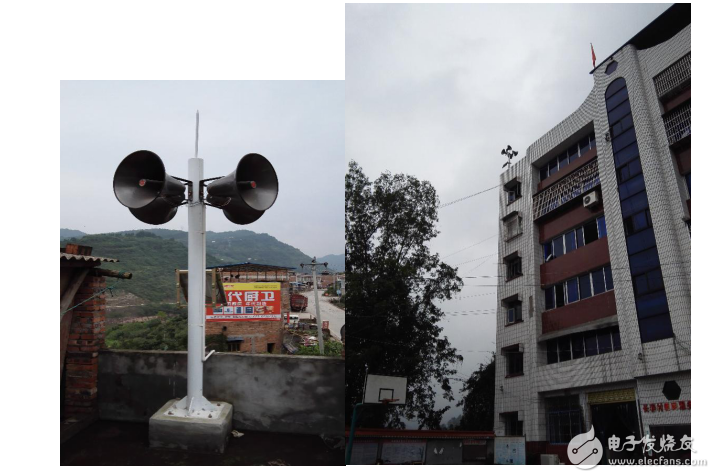
All work is performed using mature methods and has the most modern practical experience in the design and manufacture of power station auxiliary system control equipment. All work should be done by skilled workers in the relevant professions and professions. All components should be accurately machined to standard specifications for easy replacement and maintenance. All bolts, nuts, screws, rivets, threads, units of measure, or dimensions should be consistent with practical standards. For the correct installation of the equipment, the contractor shall provide all necessary fastening equipment and support devices.
Installation method
The wireless early warning broadcasting station adopts a single rod installation method. The main unit and the battery are placed in the chassis. The hoop is installed on the pole. The solar panel is installed on the galvanized steel pipe and faces the south direction. The wireless early warning radio bracket Use Φ167mm*4500mm hot-dip galvanized steel pipe welding, make and use 2000*2000*1000mm rammed bottom seat, use Φ16mm expansion bolt to fix the bracket of the broadcasting station main body on the base; wireless early warning radio installation must meet the following requirements:
Can erect or use existing buildings, no less than 1.5 meters above the surrounding buildings;
Fixed pedestal wind resistance class 10;
The installation shall comply with the relevant requirements of the "Safety Requirements for Hydrological Instruments" (GB 18523-2001) and "Basic Parameters and General Technical Conditions for Hydrological Instruments" (GBT 15966-2007);
The wiring should be standardized and comply with current relevant standards;
Bracket material: hot galvanized pipe;
Equipment strictly in accordance with the standard lightning protection installation;
The installation diagram is as follows
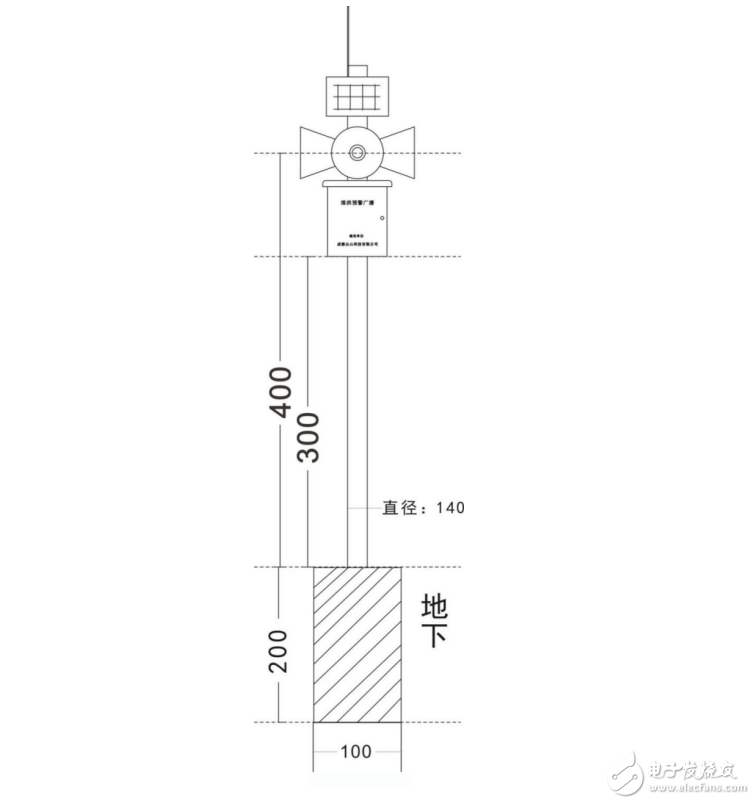
Application case:
Chengdu Zhongshan Science and Technology Flood Discharge Early Warning Equipment Application in a Village in Sichuan
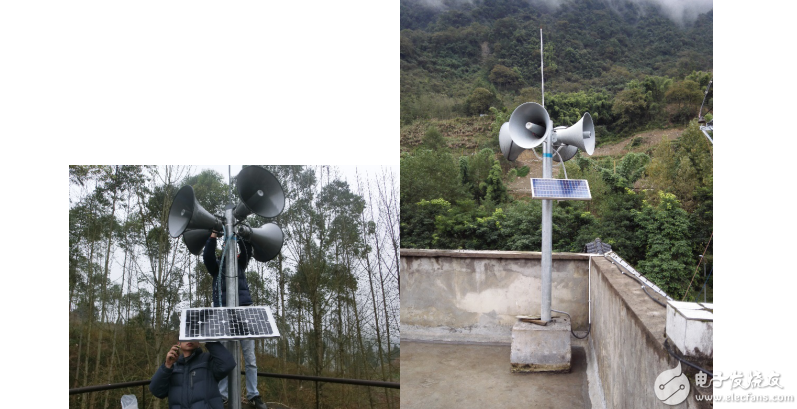
Related Products:
Simple Rain Alarm
ZS.JBD-05 Simple Rain Alarm is a rainfall statistics and automatic analysis and forecasting device specially developed for the application of disaster warning systems. The system is mainly composed of a rain barrel and an alarm. Rainfall barrels can be divided into wireless and wired ways to connect with alarms. When wireless mode is adopted, rainfall barrels have a built-in wireless transmission module, which collects real-time rainfall and sends them to alarms. The alarm statistics/analysis of rainfall. The alarm comes with a large LCD screen, beautiful and practical, using mains power supply, with 3 AA batteries as a backup battery
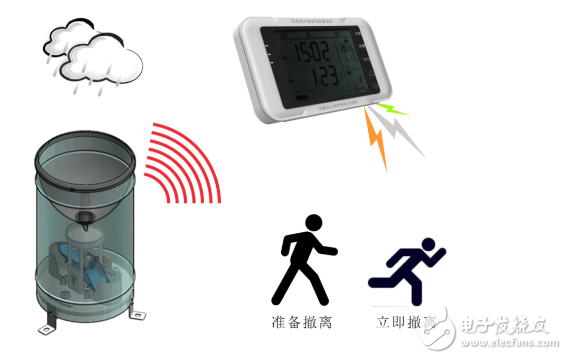
Simple water level alarm
In order to further supplement and improve the existing mountain flood warning system, Chengdu Zhongshan Technology Co., Ltd. has designed and developed a simple water level alarm. The simple water level alarm is a monitoring and warning terminal that integrates the functions of super alert water level monitoring, information display and super alert water level alarm. It consists of a water level monitoring sensor and an alarm device, and the devices are wirelessly connected.
The self-reported self-test of the simple water level alarm solved the problem that the traditional monitoring and early warning system for mountain flood prevention must rely on the public network and the county-level monitoring and early warning platform.
The self-rescue capability of local villagers minimizes the loss of people’s lives and property.
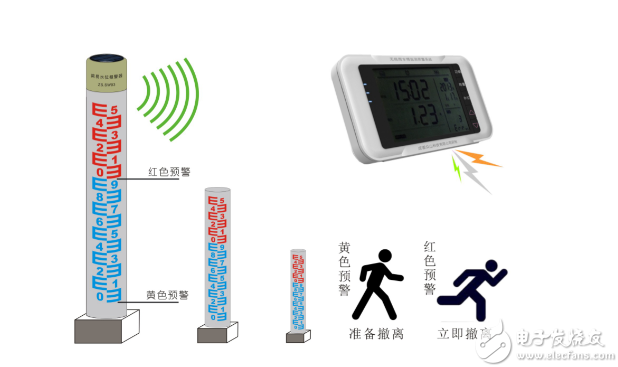
Tension Compression Force Sensor
Miniature Force Sensor are designed for compression and tension and known for their small package size. They are used in tight and limited spaces. Miniature load cells are available in various capacities ranging from 5N to 200KN and in packages ranging from 8mm to 51mm OD. (can customized the Load Cell size) , the force sensors are widely used in Medical applications as well as automation where small size is a must and space is limited. If space is not an issue and higher precision is required then use a pancake style load cell. Rolling element bearing load measurement is an application where load buttons are utilized.
miniature load cell,Tension Force Sensor,miniature Force Sensor,button Load Cell,small load cell
GALOCE (XI'AN) M&C TECHNOLOGY CO., LTD. , https://www.galoce-meas.com